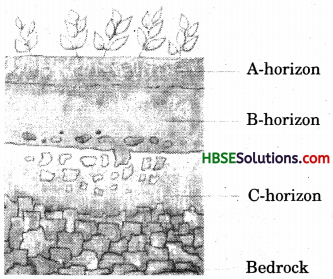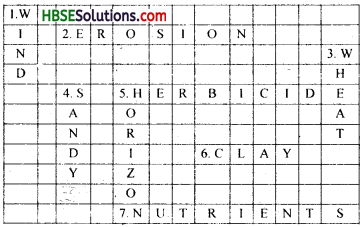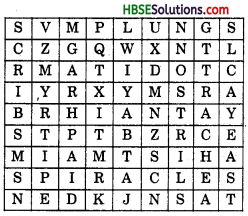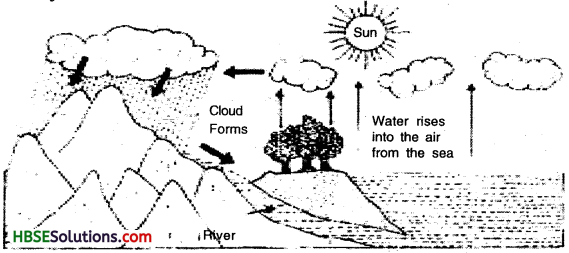Haryana State Board HBSE 7th Class Science Solutions Chapter 9 Soil Textbook Exercise Questions and Answers.
Haryana Board 7th Class Science Solutions Chapter 9 Soil
HBSE 7th Class Science Soil Textbook Questions and Answers
Tick the most suitable answer in questions 1 and 2.
Question 1.
In addition to the rock particles, the soil contains:
(i) air and water,
(ii) water and plants
(iii) minerals, organic matter, air and water
(iv) water, air and plants.
Answer:
(iii) minerals, organic matter, air and water.
Question 2.
The water holding capacity is the highest in:
(i) sandy soil
(ii) clayey soil
(iii) loamy soil
(iv) mixture of sand and loam
Answer:
(iii) loamy soil.

Question 3.
Match the items in column I with those in column II:
| Column I | Column II |
| (i) A home for living organisms | (a) Large particles |
| (ii) Upper layer of the soil | (b) All kinds of soil |
| (iii) Sandy soil | (c) Dark in colour |
| (iv) Middle layer of the soil | (d) Small particles and packed tight |
| (v) Clayey soil | (e) Lesser amount of humus |
Answer:
| Column I | Column II |
| (i) A home for living organisms | (b) All kinds of soil |
| (ii) Upper layer of the soil | (c) Dark in colour |
| (iii) Sandy soil | (a) Large particles |
| (iv) Middle layer of the soil | (e) Lesser amount of humus |
| (v) Clayey soil | (d) Small particles and packed tight |
Question 4.
Explain how soil is formed.
Answer:
Soil has been formed from parent rock material over millions of years. The process by which soil formation takes place is called weathering. Weathering is a very slow and gradual process during which parent rock material breaks down into fine particles.
The agents which bring about weathering are many. These are described below:
1. Temperature changes:
Rocks expand when heated and contract when cooled. The hot sun causes the surface layers of rocks to expand more than the layers deeper down. These changes cause the rock surface to break apart.
2. Frost:
Rainwater may become trapped in small crevices of the parent rock. In winter, this water freezes to ice. The ice expands producing a lateral pressure, causing the crevices in the rocks to further open up.
3. Water:
Continual movement of rain and river water, in liquid form, causes breaking down of rock particles into finer particles through their abrasive effect.
4. Wind:
Wind blowing across a rock surface also has a abrasive effect on the rocks. Minute rock particles are carried away by the blowing wind and deposited elsewhere.
Question 5.
How is clayey soil useful for crops?
Answer:
Clayey soils are very useful for crops, because these soils:
(i) contain humus, providing fertility to the soil
(ii) hold sufficient water due to the presence of smaller particles, and
(iii) contain enough air due to the presence of some large particles alsy.
Question 6.
List the differences between clayey soil and sandy soil.
Answer:
Clayey soil:
Clayey soil contains more than 50% of clay particles. Since the clay particles are very small in size, they are very tightly packed and do not allow water to drain out easily. It is poorly aerated because the tightly bound clay particles leave little space in between to trap air. Clayey soil is very sticky and thus tilling the soil is very difficult. However, it is rich in minerals which makes it suitable for plant growth. Due to the great binding capacity of its particles, clayey soil is used for making toys and pots.
Sandy soil:
Sandy soil contains about 60% of sand particles with small amounts of silt and clay. It is very porous and its water holding capacity is very low as all the water easily runs down through the large pores. This type of soil is, therefore, not good for the growth of plants. It is found mainly in the deserts.

Question 7.
Sketch the cross section of soil and label the various layers.
Answer:
 Soil profile
Soil profile
Question 8.
Razia conducted an experiment in the field related to the rate of percolation. She observed that it took 40 min for 200 mL of water to percolate through the soil sample. Calculate the rate of percolation.
Answer:
Formula: Percolation rate
\((\mathrm{mL} / \mathrm{min})=\frac{\text { amount of water }}{\text { percolation time }(\mathrm{min})}\)
= \(\frac{200 \mathrm{~mL}}{40 \mathrm{~min}}\)
= 5 mL /min.
Question 9.
Explain how soil erosion could be prevented.
Answer:
Prevention of soil erosion can be brought about by controlling the factors which cause soil erosion. The methods would, thus, be as follows:
1. Deforestation should be stopped. Rather, trees should be planted (afforestation). Afforestation should be undertaken not only in areas already cut, but additional areas should be brought under plantation.
2. To reduce the effect of strong winds in the fields, the boundaries of the fields should be planted with trees in two to three rows.
3. To maintain the soil in its natural condition, it is advisable to grow different crops. Crops rotation, as it is called, helps to maintain the fertility of the soil. The water-holding capacity of the soil is also maintained by this method.
4. Proper drainage and irrigation arrangements should be made in the fields.
5. On the sloping areas in hills, strip cropping should be practised, thereby reducing the steepness of the slopes and checking soil erosion.

Question 10.
Solve the following crossword puzzle with the clues given:

Across:
2. Plantation prevents it.
5. Use should be banned to avoid soil pollution.
6. Type of soil used for making pottery.
7. Living organism in the soil.
Down:
1. In desert soil erosion occurs through.
3. Clay and loam are suitable for cereals like.
4. This type of soil can hold very little water.
5. Collective name for layers of soil.
Answer:

Extended Learning – Activities And Projects
Question 1.
Boojho would like to know the difference between raw and baked soil? Investigate how the soil from which matkas are made is different from the soil used to make status.
Answer:
Do yourself. Take help your teacher.
Question 2.
Paheli is worried. She could see a brick kiln from her house. Bricks were being made there. There was so much smoke coming out of the kiln. She was told that the best quality of clay is required for making pottery, statues and bricks. She has seen truck loads of bricks being taken away for construction of buildings. At this rate, she fears, no soil will be left. Are her fears justified? Discuss this problem with your parents, teachers and other experts of your area and prepare a report.
Answer:
Do yourself.
Question 3.
Try to find out the moisture content of a soil sample. One method is given here.
Activity: Take lOOg soil. (Take help from any shopkeepers to weigh the soil). Place it on a newspaper in the sun and allow it to dry for two hours. This activity is best done in the afternoon. Take care that the soil does not spill outside the newspaper. After drying it, weigh the soil again. The difference in the weight of the soil before and after drying gives you the amount of moisture contained in 100 g of soil. This is called the percentage moisture content.
Suppose your sample of soil loses 10 g on drying. Then
Percent of moisture in soil
= \(\frac{\text { wt. of moisture }(\mathrm{g})}{\text { Original wt. of soil sample }(\mathrm{g})} \times 100\)
In this example
Percent of moisture in soil
= \(\frac{10 \times 100}{100}=10 \%\)
Answer:
Do yourself.
HBSE 7th Class Science Soil Important Questions and Answers
Very Short Answer Type Questions
Question 1.
Define soil.
Answer:
Soil is uppermost layer of earth’s crust, in which plants grow.
Question 2.
Define weathering.
Answer:
Soil is formed from the parent rock material by a very slow and gradual process called weathering.
Question 3.
What is humus?
Answer:The rotting dead matter in the soil is called humus.
Question 4.
Where do plants grow?
Answer:
Plants grow in the soil.
Question 5.
Where does food that helps to sustain and grow, come from?
Answer:
Plants.
Question 6.
How old is our earth?
Answer:
Our earth came into existence about 4.5 billion years ago.
Question 7.
Name the part of the environment which supports life.
Answer:
1. Lithosphire
2. Hydrosphere
3. Atmosphere.

Question 8.
Give one term for the following,
“Removal of top soil by air and water.”
Answer:
Soil erosion,
Question 9.
What do you understand by the term soil conservation?
Answer:
Prevention of soil erosion is called soil conservation.
Question 10.
What is soil pollution?
Answer:
When the structure and properties of the soil are changed by adding unwanted and harmful substances, it is called as soil pollution.
Question 11.
Name two soil pollutions.
Answer:
(i) Insecticides and herbicides
(ii) Industrial wastes like plastic, chemicals, flyash, leather etc.
Question 12.
How soil erosion takes place?
Answer:
When the over grazing or cutting of trees take place the top soil becomes soft and loose which is easily blown by wind and water.
Question 13.
How is soil formed?
Answer:
Soil is formed by cracking of rocks due to contraction and expansion by cooling and heating effect.
Question 14.
What is mineral?
Answer:
Minerals are the non-renewable natural resources.
Question 15.
Name four animals that live in the soil.
Answer:
Bacteria, Earthworm, Snakes, Rats, Ants.
Question 16.
What do you understand by deforestation?
Answer:
When the trees of the forest are cleared to convert the forest land into formland is called deforestation.

Question 17.
State two major problems caused by excessive deforestation.
Answer:
(i) Due to excessive deforestation there is less rain.
(ii) Soil erosion takes place.
Question 18.
Name the materials present in fertile soil.
Answer:
Fertile soil contains nitrates, phosphates, water soluble salts and carbonic acids.
Question 19.
What is crumb?
Answer:
The main skeleton of a fertile soil is called crumb.
Question 20.
What, is the function of air in soil?
Answer:
(i) Air helps, 1:he plants present in the soil in respiration.
(ii) It helps in making soil soft and light in weight.
Question 21.
Which soil horizon is rich in humus?
Answer:
The uppermost layer is called the A- horizon is rich in humus.
Question 22.
Which type of soil is best suited for growth of plants?
Answer:
Loamy soil.
Question 23.
Name the different types of particles present in soil.
Answer:
Soil consists of soil particles, humus (organic matter), water, air and living organisms.
Question 24.
What is strip, cropping?
Answer:
Strip cropping means the planting of crops in rows or strips to check flow of water.
Question 25.
What are loams?
Answer:
Soils having mixtures of different sized particles are called loams or loam soils.
Short Answer Type Questions
Question 1.
What are the components of soil?
Answer:
Some of the main components of soil are as follows:
(i) Humus
(ii) Minerals
(iii) Water
(iv) Air and
(v) Micro organisms 7 bacteria, fungi, insects, larvae and many other organisms.

Question 2.
Write the importance of Humus.
Answer:
Humus is very important for the proper growth of the plants. It helps in growing plants in the following ways:
(i) It makes the soil fertile.
(ii) It allows the roots of plants to penetrate in the soil easily.
(iii) Water and air can pass into it easily,
(iv) It retains water for a longer period.
(v) It binds the soil particles.
Question 3.
What is meant by term wehtherifig?
Answer:
The cooling and heating of rocks cause cracking. They bring about further breaking. This process of breaking the parent rock into fine particles is called weathering.
Question 4.
Describe the harmful effects of deforestation.
Answer:
Deforestation causes the following harmful effects:
(i) Soil erosion will take place.
(ii) There will be draught due to which famine will occur. .
(iii) There will be less rain.
(iv) There will be excess amount of CO, due to which Green House effect will take place. It may cause flood in-the rivers.
Question 5.
Why biosphere supports life?
Answer:
Biosphere has all those requirements such as air, water, minerals, sunlight etc. which are essential for the survival of living things.
Question 6.
What are natural resources?
Answer:
Natural resources are those which are provided by nature to support life. Such as water, air, minerals, sunlight and various life forms.
Question 7.
What is soil erosion?
Answer:
The top soil being soft and light is carried away easily by wind and water, the natural agents. This process of removal of soil is called soil erosion.
Question 8.
Distinguish between residual and transported soils.
Answer:
Residual soils are those in which the whole process of soil formation, i.e., weathering and development of soil profile occurs at the same place. In these soils, the soil is formed at the place where the parent rock is present.
Transported soils are those where the v weathered soil particles are taken away to other places. This is done by several agents.

Question 9.
State any four major advantages of forests.
Answer:
Forest is a natural renewable resource which is advantageous in the following ways:
(i) It creates a suitable environment for rain.
(ii) It helps in controlling the soil erosion.
(iii) It absorbs excess rain water as subsoil water.
(iv) It provides the home to variety of animals.
Question 10.
What is the importance of soil organisms?
Answer:
A number of organisms such as earthworms, bacteria, fungi and round- worms are found in the soil.
Soil organisms are important because of various uses:
1. As you know, earthworms burrow the soil, swallow it and make it loose and soft.
2. Micro-organisms cause the decomposition’ of dead plants and animals, and release the minerals back of the soil. The minerals can again be absorbed by the plant roots. Mineral cycling goes on in this manner.
3. Some bacteria are able to fix nitrogen in association with roots of legume plants like pea and gram.
Long Answer Type Questions
Question 1.
How is soil important to us? Explain.
Answer:
Our mother Earth is blessed with immense land resource. It is valuable to man for food production. It is also a basic part of wildlife habitats and recreational resources. Various soil organisms like earthworms, bacteria, insects and mammals use this as a natural habitat. Plants obtain water and minerals through this land resource. Plant sources of many medicinal drugs exist here. Wood fibres, fruits, rubber, oils, dyes and various other economic products which the man uses, are all dependent on this land. The very existence of mankind is greatly influenced by this land resource.
Question 2.
Describe the factors which cause soil erosion.
Answer:
Soil erosion is the removal of topsoil. This is brought about by wind and water or rain. There are several factors which allow water and wind to cause soil erosion. Some of these factors are:
(i) Deforestation:
Cutting down of trees and excessive farming are practices that destroy vegetation and expose land to the action of wind and water. Water runs off the soil surface with great speed and carries the soil particles into rivers which get chocked with silt resulting in floods. This problem assumes alarming proportions on hills.
(ii) Overgrazing:
Overgrazing by animals also destroys vegetation making land barren. The top soil on barren land can then be eroded by water and wind.
(iii) Poor methods of farming:
Tilling or ploughing loosens the soil which can then be easily eroded by wind and water. Due to excessive farming the layer of humus gets depleted and water holding capacity of the soil also reduces. The topsoil thus dries up and can be carried away by wind and water.
(iv) Forest fires, too, lead to soil erosion. After fire, the soil is exposed to two main factors causing erosion, namely wind and water.
Question 3.
Write short notes on the importance of the following:
(а) Soil, (b) Forests, (c) Soil organisms, (d) Overgrazing, (e) Earthworms.
Answer:
(a) Soil:
(i) Soil provides shelter to several micro-organism and some macro- organisms.
(ii) All the plants grow in it.
(iii) It acts as store-house of minerals.
(iv) It acts as raw material for building bricks, mortar, pottery, pulp for paper industry is. obtained from plants grown in the soil.
(v) It acts as water storage.
(vi) It provides employment.
(b) Forests: Forests are very useful to man-kind in the following ways:
(i) It maintains the balance of gases in the atmosphere.
(ii) It causes rain.
(iii) It provides the shelter to the wild animals.
(iv) It provides the valuable things like timber, honey, bee wax, lac, medicines.
(c) Soil Organisms:
Various micro organisms live in the soil which make the soil porous, soft and airy. They make soil fertile. They convfert manure into simple form which can be used by plants of the forest.
(d) Overgrazing:
When the cattle , eat grass of l^rge area, it is called as overgrazing. This process makes the soil plain which can be used for industrialisation and urbanisation.
(e) Earthworm:
Earthworms are the friends of the farmer. They eat dead organicv substances along with the soil and convert them into simple soluble forms which make the soil fertile and soft.

Question 4.
Describe the composition of soil.
Answer:
Composition of soil varies from place to place. It depends on the type of rock from which it is formed. However, all soils contain the following components:
(i) Rock particles: Tiny particles of soil derived from the parent rock.
(ii) Humus: Humus consists of decaying remains of plants and animals.
(iii) Living organisms: Soil contains a large number of micro-organisms like bacteria, algae, fungi and protozoa. Many small animals like insects, earthworms, spiders, scorpions, centipedes and millipedes are found in the soil. Burrowing animals like rats, moles, rabbits and guinea pigs make tunnels in the soil.
(iv) Water: Water is present in pores between soil particles and helps the plants in their growth.
(v) Air: Air is also present in the soil pores and is essential for the survival of living organisms present in the soil.
Question 5.
What is soil pollution? What are the major sources of soil pollution?
Answer:
Any substance that adversely affects the, productivity of soil is called a soil pollutant. Contamination of soil with pollutants like insecticides, artificial fertilizers and industrial wastes is called soil pollution. The major sources of soil pollution are:
(i) Pollutants like acids washed off from the atmosphere (acid rain).
(ii) Pesticides and herbicides sprayed in fields.
(iii) Excessive use of artificial fertilizers.
(iv) Solid wastes like garbage, trash, ash, building material, plastic bottles and cans.
Soil Class 7 HBSE Notes
1. Soil is the uppermost layer of earth’s crust, in which plants grow.
2. Soil is formed from the parent rock material by a very slow and gradual process called weathering. A number of agents temperature changes, frost, water, wind and living organisms – are involved in the weathering of rocks.
3. Six types of soil are mainly found in India – Red soil, black soil, alluvial soil, desert soil, mountain soil and laterite soil. Humus content is maximum in mountain soil. Black soils are rich for growing cotton and sugarcane while alluvial soil is suitable for wheat and rice.
| Types of soil | Occurrence | Characteristics |
| 1. Red soil | Interior regions of Kerala and .Tamil Nadu, Southern Karnataka, Andhra Pradesh, Orissa, Eastern Madhya Pradesh. | (i) Red colour due to the presence of iron oxide. (ii) Poor in humus but can be made fertile by adding manure or fertilizers. |
| 2. Black soil | Maharashtra, parts of Andhra Pradesh, Madhya Pradesh and Gujarat. | (i) Rich in iron and magnesium, derived from basaltic rocks. (ii)Soil is clayey, contains dead organic matter and water ideal for growing cotton and sugarcane. |
| 3. Alluvial soil | Plains of Haryana, Punjab, Uttar Pradesh, Bihar, West Bengal, Coastal Orissa and Andhra Pradesh. | (i) Loamy in texture with plenty of humus. (ii)Very fertile; good for crops like wheat and rice. |
| 4. Desert soil | Rajasthan and some parts of Gujarat. | (i) Soil sandy and porous, cannot hold much water. (ii) If irrigated, crops can be grown. |
| 5. Mountain soil | Himalayan region and north-east India. | Of all the soil types, humus content is maximum in this type and, thus, it is very fertile. |
| 6. Laterite soil | Found in regions with heavy rains; parts of Tamil Nadu, Andhra Pradesh, Orissa and Assam. | (i) Soil rich in nutrients. (ii) Good for plantation of tea, coffee and coconut. |
4. There are three main layers or horizons in the soil profile – A-horizon (top soil), B horizon (subsoil) and C-horizon (parent rock).
5. Soil consists of soil particles, humus (organic matter), water, air and living organisms.
6. Soil particles, depending on size, consist of clay (below 0.002 mm), silt (0.002 to 0.02 mm), sand (0.02 to 2.0 mm) and gravel (above 2.0 mm).
7. A soil containing a mixture of sand, silt and clay is called a loamy soil. It is the best soil for plant growth.
8. Soil is an important natural resource. It provides us food, clothing, shelter, medicines,
rubber, dyes and a number of other useful products. Besides man, it provides shelter to wildlife and different soil organisms.
9. Wind and rain bring about loss of the top soil (soil erosion). Deforestation, over grazing and poor farming methods have accelerated the process of soil erosion.
10. Prevention of soil erosion (soil conservation) can be brought about by growing plants (afforestation), crop rotation, prevention of overgrazing maintaining proper drainage, and growing crops in rows or strips in the hills (strip-cropping).
![]()
![]()
![]()
![]()
![]()
![]()

 Soil profile
Soil profile




